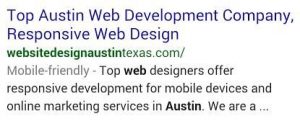Everyone who has used a smart phone at one point or another has experienced this. You search for something online and find what appears to be a great website. Then you click on the link. Suddenly you feel like you need reading glasses because the text is so small. You have to swipe your screen from right to left just to continue to read the content. Or worse yet, the whole site is unavailable because it requires an Adobe Flash player. All of these are signs of a website that is not mobile friendly.

According to Google, to qualify for this label from the Googlebot, your site must adhere to the following:
- Avoids software that is not common on mobile devices, like Flash
- Uses text that is readable without zooming
- Sizes content to the screen so users don’t have to scroll horizontally or zoom
- Places links far enough apart so that the correct one can be easily tapped
While it is easy to understand why these guidelines would be in place, it may not be easy for you to find out if the Googlebot thinks your site qualifies. Google has provided a nifty Mobile-Friendly Test tool where you enter your website address and the bot crawls it in about a minute.
As if you needed another reason to have a responsive website, Google has pretty much made the decision for you. Once the “mobile-friendly” label is global, it will be one more reason for someone to decide whether or not to visit your site. On top of that, Google will eventually add to responsive design positively to their algorithm, which will effect search results ranking. Don’t let yourself be ruled out before folks even have a chance to see what you have to offer! Contact us to see how we can help make your website responsive.
